Noticias
FIELD TEST - XP BATEA
Originally published in the November December 2020 Issue of the Gold Prospectors Association of America’s Gold Prospectors Magazine.
- Photos AND Story by Kevin Hoagland
Let’s start out with a show of hands for these questions. How many of you have heard of a Batea gold pan? How many of you have seen a Batea? How many of you have used a Batea?
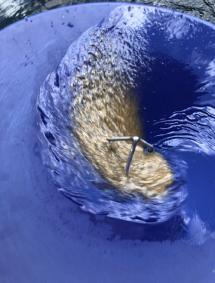
You might be surprised at your own answers. The Batea is most likely the oldest gold pan design in the world and if you have ever watched a documentary on mining in any part of the world other than North America, you have seen a Batea. And for those of you that answered yes to having used a Batea, have I got a lot to share with you.
My first introduction to the Batea was in South America years and years ago when I had the opportunity to make a prospecting trip with a friend who lived in the area. He suggested that I bring along a bunch of gold pans to use as trade material for info on places to prospect. It worked to some extent for a few days. Let’s just say when I came back around, most, if not all, of the pans I had traded were being used for anything other than a gold pan.
What is a Batea? Simply put it is a gold pan that is funnel in shape, no riffles, that will run a great deal of material very quickly with a very high recovery rate after you get used to the action of the pan — which will take you a couple of hours.
But before we delve into the Batea I do want to make a statement. Creating something and bringing it into any market that is not new or an improvement over what is already out there to me is a waste of your time and mine. There are enough doodads in the world today that just make no sense to me at all. So, when I choose an item to test it has to come to the shop either as new or with improvements that makes it stand out from anything else and have a value. With that said, let me introduce you to the XP Batea. This is a tool that I never saw coming from the team at XP Detectors in France and which I consider not only new in its development, but a definitive improvement.
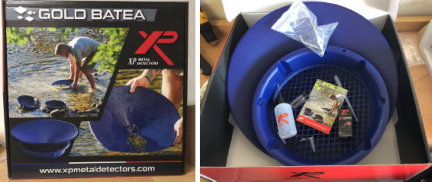
XP took the oldest gold pan known to man and did more than just update the design and build material — they pretty much reinvented the wheel, and it is a better wheel.
Full disclosure: XP did send me the Batea to test. Which is fine that they did, but I had already ordered two full Gold Batea kits for myself when I first saw the Batea, which I expect to have as soon as retail units are readily available to the United States distributers.
Enough of that, let’s get to the unboxing and assembly (yep, some assembly required) to fully utilize the Batea and well worth the few minutes it will take getting it ready to get some gold in the trap.
Opening the box, you realize that the Batea is a big pan, measuring 20 inches across, and right at 5 inches deep there is no mistaking it for any pan you have in your gear box right now. The Batea is packed upside down in the box and the first thing I noticed was the deep center recessed catch area of the pan. The nub you see when the Batea is upside down is about a half-inch deep and half-inch across, making it a perfect catch to let the gold fall into and keep panning when out in the field. Next is the three drill hole guides and then the honeycombed upper flat ridge at the top of the pan. Unlike other Bateas, the flat area surrounding the upper edge of the pan instantly gave me a good flat grip on the pan. Other Bateas of traditional designs are straight-edged pans with very little to no lip to get a good grip on. The pan was instantly comfortable in my hands. More importantly, though, the honeycombed glass fiber plastic construction makes this pan extremely rigid.
It is also very blue for a reason. XP spent some time in finding a color that created the best contrast of gold in the Batea that makes the gold pop compared to the other minerals. In my testing and comparing this to a couple of other blue pans, I will agree that they chose the right color. The difference is subtle from other blue pans that I have and just enough to make that slight difference.
Also included in the box is the XP classifier, which is more of a diamond than the square classifiers I am used to using. The classifier has a number of external touchpoints to let it sit comfortably in a 5-gallon bucket, offers more than enough room to wet or dry classify without the classifier getting stuck on the bucket rim and, frankly, it looks tough as nails.
After that there are two accessory bags and the instructions on how to use the Batea, which I found to be really informative (I learned to use a Batea with an extreme language barrier) and is a must-read to use the Batea to its best potential. The first bag included a very soft snuffer bottle that is ringed on the inside to prevent gold getting into the straw/lid contact, which is something that bothers me about a lot of lower quality snuffers; there is also a 2-ounce glass vial, pipette, assorted tube covers and a 3x6 loop.
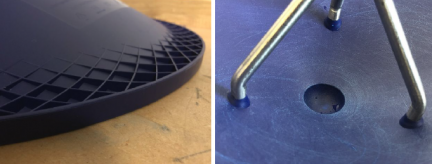
But it was the second bag that I was more interested in: the Defragmenter and its associated parts. When I first learned of the XP Batea and saw the Defragmenter, I was very intrigued with the idea, but when I ordered my Batea I ordered two full kits in the event that it did not live up to the hype. I am glad to say that both of my personal Bateas will be fitted and used with the Defragmenter installed.
The Defragmenter is an ingenious idea that allows the prospector to use the Batea with just about any material, including many clay-based soils, with no effort to break up the material to pan. The Defragmenter does all the work, settles your gold fast in the trap and allows you to work your material pretty quickly right out of the box, which I do not suggest you do. Spend some time getting used to the new panning style of the Batea before you enter that next panning competition.
The Defragmenter is what I would call a three-bar pyramid design made of stainless steel that bolts into the pan. Yes, bolts into the pan. The bag also contains three stainless nylock nuts and three angled spacers to assure that everything is in perfect alignment.
To install the Defragmenter, the twist drill measurement is .5mm in the manual, which converts to about 3/16. I opted after measuring the defragmenter threaded shaft with a micrometer to use one step down, or 11/64. Flipping the Batea upside down, the 11/64 fit the guide holes perfectly. When I had plumb and level, I drilled the three holes needed to install the Defragmenter, and flipped the pan back over to deburr the holes. I was ready to install the Defragmenter when I realized that I needed to “season” the Batea before installing the Defragmenter. The panning surface has a very slight amount of texture to it already, so I was not concerned about roughing it up too much, but I did want to remove the releasing agent from the surface of the pan. I used my typical mix of Dawn and Fast Orange pumice soap, then a final good scrubbing with just Dawn to eliminate any of the orange oils picked up from the first scrubbings.
Back at the workbench I installed the tapered spacers, pushed the legs through the holes and put the nuts on hand tight to begin. Checking the alignment of the tapered spacers to assure they were in the right orientation, I flipped the Batea back over and, using a 7mm socket, I tightened the nuts just past locking into the nylon lock in each nut. Do not over tighten these nuts. You will most likely collapse the spacers, which will cause you all sorts of grief. The entire operation of installing the Defragmenter was about three minutes.
Batea ready, now it's time to run some material through this monster, except for one problem. I live in the middle of a desert, the monsoons passed us by and aside from tub testing, the closest water is almost three hours away. Well, I have to make lemonade out of lemons for the time being. Filling the largest tub I have, I quickly concluded that my biggest tub was not big enough. Off to the feed store for a 110-gallon water trough. Back home and trough full, I decided to start out with a gold bag that I recently picked up from Goldbay.
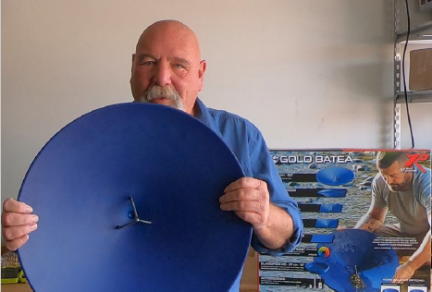
The action is different from what you are used to. With your material in the Batea, flood it with water and move back and forth and side to side to stratify your material, keeping it flat and occasionally making a circular motion. The Defragmenter is the key to breaking down the material and it did a great job in creating a lot of turbulence in the water, causing the heavies to drop really quicky and keeping the waste in suspension ready to exit off the side. After a few seconds of stratification, I placed a rubber cap over the gold trap and just inside the Defragmenter, and dumped the remaining material into a catch pan to see how quickly the Batea got the gold into the trap. There were three 100- mesh specks of gold in the material that didn’t make it to the bottom in that short of time. Dropping in another catch pan and dumping the working material in segments to the trap, I found just a few more 100-plus mesh pieces. The bottom line is that with just a more than a quick stratification of the material, the gold would be where it was supposed to be, in the trap.
Adding the waste material back into the pan and a bit of iron black sand, I began working the Batea properly. And this is where you will be getting used to a completely new panning technique.
Stratifying the material again, dip the pan into the water while making a circular motion with the pan, keeping the material edge just underwater as you swirl the pan. As the water continually enters the Batea, the lighter material is forced out by the swirling action and heavies are forced into the recovery area. As XP Batea European tester Jean- Luc Billard says, “Get a little whirlpool started in the pan.” Re-stratify after a few complete swirls and start the process of creating the whirlpool again and repeat the process. In very short order you will be down to your final material.
It is very important to know that the Defragmenter’s turbulence is a vital part of each step of the Batea panning process and that this addition makes it innovative in design and function — from breaking down the rough material to the turbulence that the Defragmenter causes in the water all the way down to final recovery. Turbulence settles gold quickly!
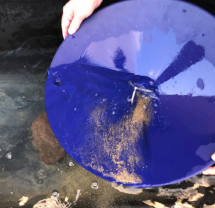
Think of this, when using any round pan (including a standard Batea), water circles around the pan in a more often than not given pattern. You have to or should be continually stratifying your material to assure that the gold is settled to the bottom of the pan and stays there. With the Defragmenter, as the water and material pass the three posts a different turbulence is generated with each pass. This assures that there is more than enough water action in the pan to take the smallest gold and force it into the trap and that the turbulence above the trap will keep it there. This does not mean that you do not re-stratify your material; just know that your restratifying effort will have a better result.
This final recovery is why I’ve liked the Batea since the first time I used one the right way and even better with the XP Batea. With the Batea flat in the water and a small amount of water in the Batea, start with a small circle motion; the light material will quickly climb the wall of the Batea. Make the circular motion larger and slower. When the last of the light material has made it up the side of the wall, tilt the Batea and strand the waste. From there you can use a snuffer bottle or your hand to wash away the waste, leaving your gold and a small amount of black sand in the recovery trap. A real benefit to the XP Batea being plastic is that at this point and until you get completely used to the recovery action, use a rare-earth magnet on the outside and drag the black iron sands up and out of the recovery area.
It is going to take a bit of time to really master the use of the XP Batea.
I know that it sounds like a lot of work, and it is for the first few hours of getting used to the different panning action. After you have the action down you will find that your speed in panning and recovery is well worth the time you took to go old school (even more old school than a metal pan) with a serious gold pan.
Time to get out of the water trough and into the river. The three-hour drive to get into big water and really start cranking on the Batea will be fun even after proving out the Batea in the backyard.
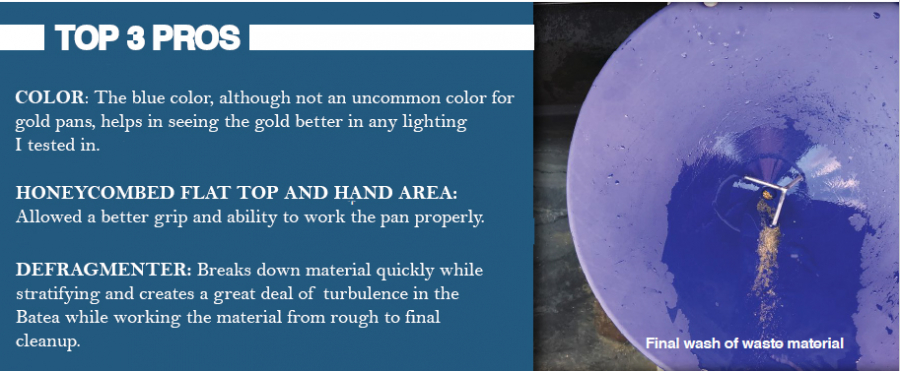
FINAL THOUGHTS
The Batea is not a novelty pan, it is a serious tool for the gear box and one that I think you will find yourself using more and more often than you think you will right now.
It is a bit bulkier than what you are used to, but the design of the flattop grip area makes all the difference in the world. Think about it this way, take your favorite gold pan and put a shelf around it to make it even easier to hold onto and use.
Now to the part about it being innovative. The Defragmenter is, as I said earlier, the key and the smartest thing I have seen done to a gold pan. Riffles are one thing, but this unit tears down challenging soils like I have never seen without the chance of blowing your gold past a riffle. Will it work on the densest clays you run into in some areas? Not entirely, but in the clays that I have panned so far in testing it is far better than anything I have used next to a mud paddle on, my drill breaking down clay in a 5-gallon bucket.
I almost forgot to mention this key factor as well. The Batea I used in South America was heavy, made of wood, and cumbersome. The XP Batea is none of those, coming in at 800 grams /28 ounces, or for those of us that weigh everything in troy, just a bit over 25 troy ounces. You will find that it is lighter than a couple of the plastic pans I bet you have in your kit now. I can assure you that this Batea weighs in a lot lighter than the metal Batea that was introduced in 2019 and the XP Batea has the advantage of the Defragmenter and being able to have a magnet slid up the side of the pan easily.
The XP Batea has found its place in my gear box. I just have one more test to do: I wonder how it’s going to work as a dry pan? I’ll let you know.
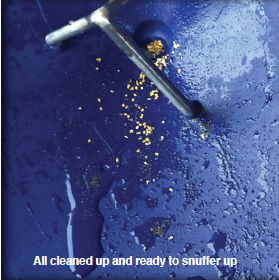
One last thought, if the Batea just doesn’t fit your needs or wants in any way, XP has also introduced a four-zone pan that is a bit more traditional in shape. One of the zones has a new and very interesting recovery area that I will be testing soon.
Kevin Hoagland is the Executive Director of Development at the Gold Prospectors Association of America and the Lost Dutchman’s Mining Association of America. He can be reached at khoagland@goldprospectors.org













Comentarios